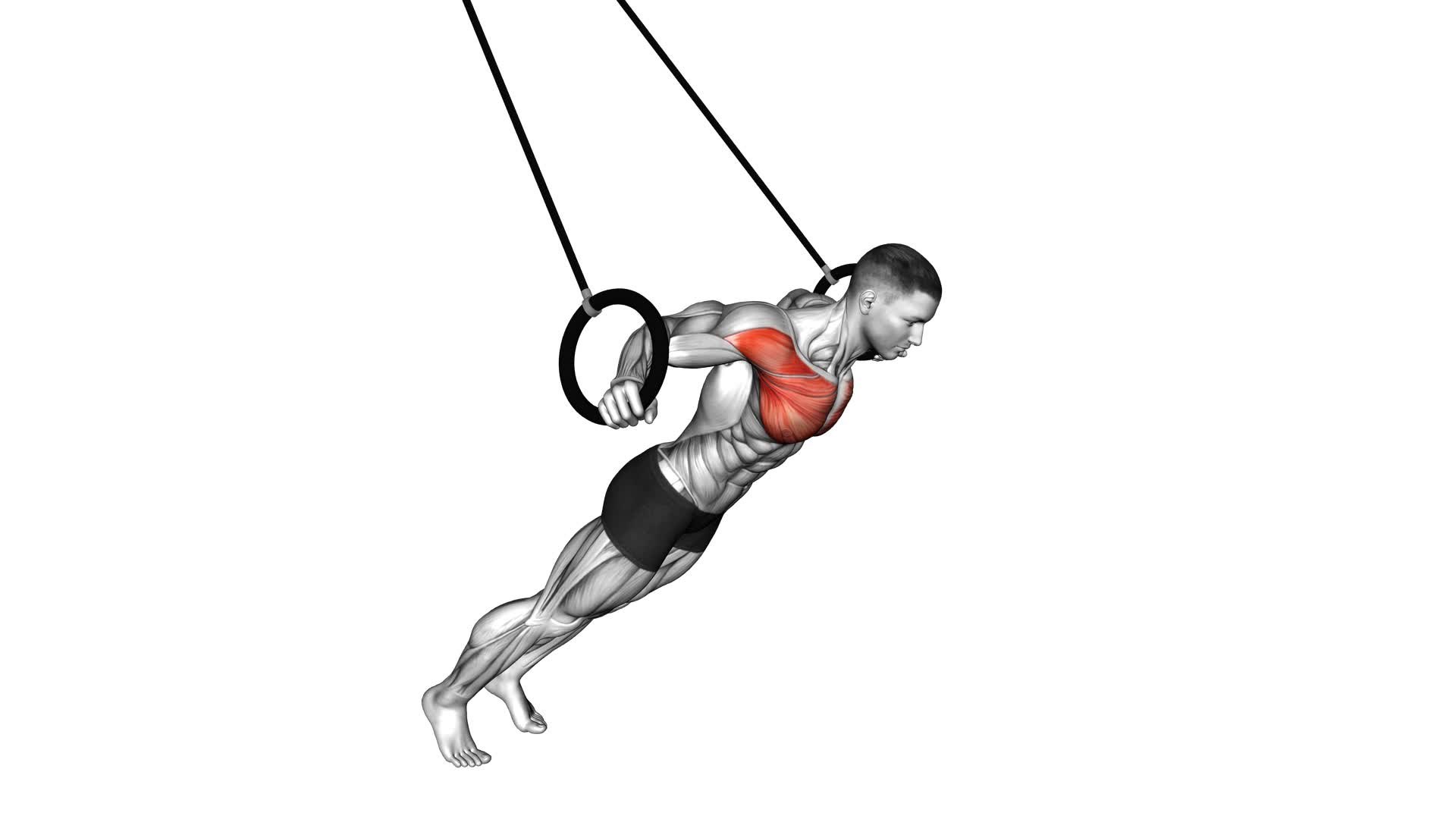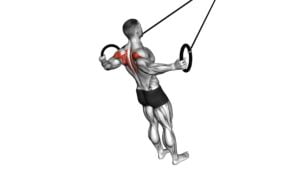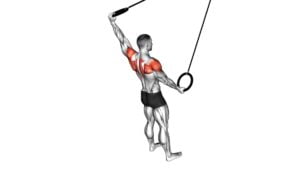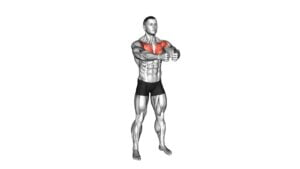Ring Chest Fly – Video Exercise Guide & Tips

Are you looking to improve your chest strength and definition? Then the Ring Chest Fly is the perfect exercise for you!
Watch This Exercise Video
In this video exercise guide, we will show you the proper form and technique to get the most out of this exercise.
We will also provide tips to increase intensity and avoid common mistakes.
So grab your rings and get ready to take your chest workout to the next level!
Key Takeaways
- Ring Chest Fly is highly effective for improving chest strength and shoulder stability.
- Proper form and technique, including maintaining a stable body position and engaging core muscles, is crucial.
- Common mistakes to avoid include using excessive weight, losing control of the rings, and flaring elbows out to the sides.
- Variation and progression can be achieved through single-arm ring chest fly, increasing resistance or repetitions, and incorporating advanced modifications.
Benefits of the Ring Chest Fly
What are the benefits of performing the Ring Chest Fly exercise?
The Ring Chest Fly is a highly effective exercise for improving chest strength and increasing shoulder stability. By using rings instead of traditional weights or machines, this exercise engages your muscles in a unique way, challenging them to work harder and develop greater strength and stability.
One of the main benefits of the Ring Chest Fly is that it targets the pectoral muscles, helping to build a strong and well-defined chest. This exercise specifically targets the muscles in the chest, allowing for a greater range of motion and a deeper stretch compared to other chest exercises. As a result, your chest muscles are able to develop more strength and size.
Additionally, the Ring Chest Fly also helps to improve shoulder stability. The instability of the rings forces your shoulder muscles to work harder to stabilize the movement, which can help to prevent shoulder injuries and improve overall shoulder strength and mobility.
Proper Form and Technique
To perform the Ring Chest Fly with proper form and technique, focus on maintaining a stable body position throughout the exercise. Here are some tips to help you execute this exercise correctly:
- Start by gripping the rings firmly with your palms facing down. Position your body at a slight angle, leaning forward with your arms extended in front of you.
- Engage your core muscles and keep your back straight throughout the movement. This will help you maintain stability and prevent any unnecessary strain on your lower back.
- As you lower your body towards the rings, make sure to keep your elbows slightly bent and your shoulders relaxed. This will allow you to fully engage your chest muscles and avoid putting excessive stress on your joints.
- Focus on a controlled and smooth motion as you push yourself back up to the starting position. Avoid any jerking or swinging movements, as this can compromise your form and increase the risk of injury.
Common errors to watch out for include arching your back, flaring your elbows out to the sides, and using momentum to complete the exercise. Remember, proper form is crucial for getting the most out of the Ring Chest Fly and preventing injury.
Now that you understand the proper form and technique for the Ring Chest Fly, let's move on to the next section about the variation: single arm ring chest fly.
Variation: Single Arm Ring Chest Fly
To perform the single arm ring chest fly, grip the ring firmly with your palm facing down and extend your arm in front of you. This variation of the ring chest fly targets your chest muscles while also engaging your core for stability.
The single arm ring chest fly offers several benefits. Firstly, it allows you to work on each side of your chest independently, helping to correct any muscle imbalances. Additionally, it requires greater stabilization from your core and shoulder muscles, increasing the overall challenge and improving your balance and coordination.
To ensure proper form during the single arm ring chest fly, start by keeping your body in a straight line from your head to your feet. Maintain a slight bend in your elbow as you lower your arm out to the side, keeping it parallel to the ground. Focus on squeezing your chest muscles as you bring your arm back to the starting position. Remember to engage your core and keep your shoulder blades down and back throughout the movement.
Now that you understand the proper form for the single arm ring chest fly, let's move on to the next section about common mistakes to avoid.
Common Mistakes to Avoid
To ensure optimal results and prevent injury, it's important to be aware of common mistakes to avoid when performing the single arm ring chest fly exercise. Here are four key mistakes to watch out for:
- Using excessive weight: It's crucial to choose a weight that allows you to maintain proper form throughout the exercise. Using too heavy of a weight can lead to improper movement patterns and increase the risk of injury. Start with a lighter weight and gradually increase as your strength improves.
- Losing control of the rings: Maintaining control of the rings throughout the exercise is essential for targeting the chest muscles effectively and avoiding injury. Be sure to grip the rings firmly and engage your core for stability.
- Flaring your elbows: When performing the ring chest fly, it's important to keep your elbows slightly bent and avoid letting them flare out to the sides. Flaring your elbows can put unnecessary stress on the shoulder joints and increase the risk of injury. Keep your elbows in line with your shoulders throughout the movement.
- Neglecting proper warm-up and cooldown: Before starting any exercise, including the single arm ring chest fly, it's important to warm up your muscles and prepare your body for the workout. Additionally, incorporating a cooldown routine can help prevent muscle soreness and promote recovery. Don't skip these important steps to avoid injury and maximize your results.
Tips to Increase Intensity
To increase the intensity of the single arm ring chest fly exercise, you can incorporate various techniques and adjustments.
One way to do this is by increasing the resistance. You can achieve this by using a heavier weight or by adjusting the tension of the rings.
Another option is to perform more repetitions or sets of the exercise. This will challenge your muscles and help to increase the overall intensity of the workout.
Additionally, you can try incorporating advanced modifications into your routine. For example, you can perform the exercise with one leg lifted off the ground or with your feet elevated on a bench. These modifications will engage more muscles and make the exercise more challenging.
Remember to always maintain proper form and technique throughout the exercise to prevent injury.
Incorporating the Ring Chest Fly Into Your Workout Routine
To incorporate the ring chest fly into your workout routine, start by adjusting the tension of the rings or using a heavier weight to increase the intensity. This will challenge your muscles even more and help you achieve better results.
Here are some tips to help you incorporate the ring chest fly into your workout routine:
- Ring chest fly modifications: If you find the standard ring chest fly too difficult, you can modify the exercise by performing it with your knees on the ground or by using a resistance band instead of rings. This will make the exercise more manageable while still targeting your chest muscles effectively.
- Ring chest fly alternatives: If you don't have access to rings or prefer not to use them, there are alternative exercises that can target your chest muscles. Some effective alternatives include dumbbell chest flies, cable chest flies, or push-ups. These exercises provide similar benefits and can be easily incorporated into your workout routine.
- Proper form and technique: It's important to maintain proper form and technique while performing the ring chest fly or any other chest exercise. This ensures that you're targeting the right muscles and reduces the risk of injury. Focus on keeping your core engaged, your back straight, and your shoulders relaxed throughout the exercise.
- Progression and variation: As you become more comfortable with the ring chest fly, you can progress by increasing the number of repetitions or sets, or by adding more resistance. You can also vary the angle at which you perform the exercise to target different areas of the chest.
Incorporating the ring chest fly into your workout routine can help you develop a stronger and more defined chest. Remember to start with the appropriate modifications or alternatives, maintain proper form, and gradually increase the intensity as your strength improves.
Frequently Asked Questions
How Many Sets and Reps Should I Do for the Ring Chest Fly Exercise?
For the ring chest fly exercise, the number of sets and reps will depend on your fitness level and goals. Generally, it's recommended to start with 2-3 sets of 8-12 reps.
This exercise targets your chest muscles and can be an effective alternative to the dumbbell chest fly.
The use of rings adds an element of instability, engaging more stabilizer muscles.
Remember to focus on proper form and gradually increase the intensity as you progress.
Can I Use Resistance Bands Instead of Rings for the Ring Chest Fly?
Yes, you can use resistance bands instead of rings for the ring chest fly exercise. However, it's important to note that using rings provides certain benefits.
Rings allow for a greater range of motion and instability, engaging more stabilizer muscles and improving overall strength and balance. They also allow for more freedom of movement, making the exercise more challenging and effective.
Is the Ring Chest Fly Exercise Suitable for Beginners?
The ring chest fly exercise can be suitable for beginners, but it's important to start with proper form and appropriate resistance.
To progress, you can increase the difficulty by adding more reps, sets, or adjusting the angle of your body.
Common mistakes to avoid include using too much momentum, flaring your elbows, or not engaging your core.
Remember to focus on controlled movements and gradually increase the challenge as you get stronger.
Can the Ring Chest Fly Exercise Help in Building Upper Body Strength?
Incorporating the ring chest fly into your workout routine can definitely help in building upper body strength. This exercise targets your chest muscles, shoulders, and triceps, making it a great addition to any upper body workout.
To get the most out of this exercise, it's important to focus on proper form and technique. Keep your core engaged, maintain a slight bend in your elbows, and control the movement throughout.
Remember to start with lighter weights and gradually increase as you get stronger.
Are There Any Modifications or Alternatives to the Ring Chest Fly Exercise for Individuals With Shoulder Injuries?
If you have a shoulder injury and are unable to perform the ring chest fly exercise, there are modifications and alternative exercises that can help you build upper body strength.
It's important to consult with a healthcare professional or a certified trainer to determine the best options for your specific injury.
They may recommend exercises such as the dumbbell chest press or push-ups with modified hand placement to protect your shoulders while still targeting your chest muscles.
Conclusion
Incorporating the ring chest fly into your workout routine can be a beneficial way to target your chest muscles. By using proper form and technique, you can maximize the effectiveness of this exercise.
Avoid common mistakes and follow the tips provided to increase intensity.
Whether you choose to do the standard or single-arm variation, the ring chest fly is a great addition to your fitness regimen.

Author
Years ago, the spark of my life’s passion ignited in my mind the moment I stepped into the local gym for the first time. The inaugural bead of perspiration, the initial endeavor, the very first surge of endorphins, and a sense of pride that washed over me post-workout marked the beginning of my deep-seated interest in strength sports, fitness, and sports nutrition. This very curiosity blossomed rapidly into a profound fascination, propelling me to earn a Master’s degree in Physical Education from the Academy of Physical Education in Krakow, followed by a Sports Manager diploma from the Jagiellonian University. My journey of growth led me to gain more specialized qualifications, such as being a certified personal trainer with a focus on sports dietetics, a lifeguard, and an instructor for wellness and corrective gymnastics. Theoretical knowledge paired seamlessly with practical experience, reinforcing my belief that the transformation of individuals under my guidance was also a reflection of my personal growth. This belief holds true even today. Each day, I strive to push the boundaries and explore new realms. These realms gently elevate me to greater heights. The unique combination of passion for my field and the continuous quest for growth fuels my drive to break new ground.







